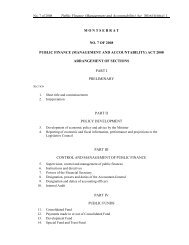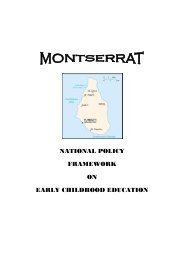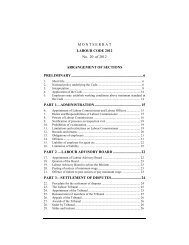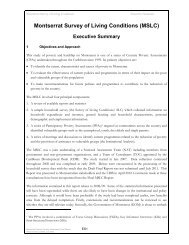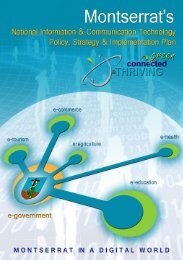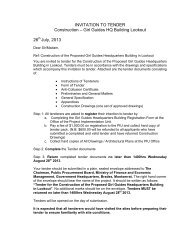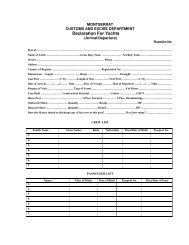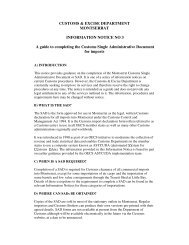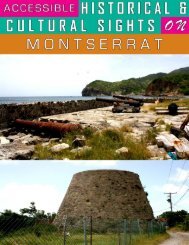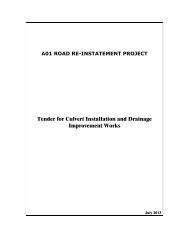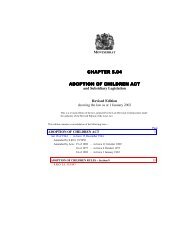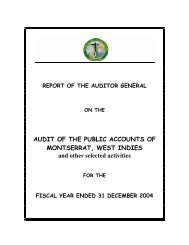guide to completing Customs procedures for exports - Customs and ...
guide to completing Customs procedures for exports - Customs and ...
guide to completing Customs procedures for exports - Customs and ...
Create successful ePaper yourself
Turn your PDF publications into a flip-book with our unique Google optimized e-Paper software.
Other export regimes.<br />
In addition <strong>to</strong> outright export of goods from Montserrat, there are a number of other<br />
types of <strong>exports</strong> <strong>to</strong> meet specific circumstances. These may require differing cus<strong>to</strong>ms<br />
export <strong>procedures</strong> <strong>to</strong> those required <strong>for</strong> outright <strong>exports</strong>.<br />
A brief description of some of the principal regimes is given below:<br />
• Transit/Transhipment – this refers <strong>to</strong> goods which enter Montserrat but are<br />
not intended <strong>to</strong> remain <strong>and</strong> are <strong>for</strong> shipment <strong>to</strong> another country. If the goods<br />
remain on board the vessel or aircraft on which they arrive, are not l<strong>and</strong>ed in<br />
Montserrat <strong>and</strong> continue their journey overseas on the same vessel or aircraft,<br />
no <strong>for</strong>mal cus<strong>to</strong>ms <strong>procedures</strong> or clearance is required.<br />
However if the goods are off loaded from one vessel or aircraft <strong>to</strong> remain on<br />
the quayside or within the airport <strong>for</strong> export on another vessel or aircraft,<br />
<strong>for</strong>mal export entry is required <strong>and</strong> the goods are subject <strong>to</strong> cus<strong>to</strong>ms clearance<br />
If the goods need <strong>to</strong> leave the port <strong>to</strong> be delivered <strong>to</strong> the airport <strong>for</strong> export by<br />
air or vice versa the goods may be subject <strong>to</strong> special cus<strong>to</strong>ms <strong>procedures</strong>.<br />
• Drawback – this refers <strong>to</strong> <strong>exports</strong> of goods, which have previously been<br />
imported in<strong>to</strong> Montserrat but which are <strong>to</strong> be re-exported in the same state <strong>and</strong><br />
refund of duty paid is being sought. There are particular conditions attached <strong>to</strong><br />
this type of export <strong>and</strong> application <strong>for</strong> approval should be made <strong>to</strong> the<br />
Comptroller. Refunds of import duty on goods, previously imported in<strong>to</strong><br />
Montserrat <strong>and</strong> subsequently exported, are not generally allowed except under<br />
the drawback regime. In all cases <strong>for</strong>mal export entry is required <strong>and</strong> special<br />
conditions may apply.<br />
• Export <strong>for</strong> repair <strong>and</strong> re-importation<br />
Goods intended <strong>for</strong> export <strong>for</strong> repair, or exchange under warranty, must be<br />
entered <strong>for</strong> export <strong>and</strong> examined by cus<strong>to</strong>ms <strong>to</strong> verify details such as serial<br />
numbers. This will facilitate a claim <strong>for</strong> duty free admission on re-import in<strong>to</strong><br />
Montserrat. Failure <strong>to</strong> enter or produce goods <strong>for</strong> examination at export may<br />
lead <strong>to</strong> duty free admission on re-import being refused.<br />
Procedures <strong>to</strong> complete export clearance at the place of shipment<br />
Once goods have been entered at the Cus<strong>to</strong>ms Longroom <strong>and</strong> the entry accepted <strong>for</strong><br />
shipment 2 copies of the SAD (also known as the export warrant) stamped by the<br />
Cus<strong>to</strong>ms at the Longroom, will be returned <strong>to</strong> the exporter or broker <strong>to</strong> enable the<br />
Cus<strong>to</strong>ms <strong>procedures</strong> <strong>to</strong> be completed at the place of intended shipment.<br />
Exporters are then advised <strong>to</strong> contact the Cus<strong>to</strong>ms at the place of intended shipment <strong>to</strong><br />
advise of the delivery of the export consignment. Cus<strong>to</strong>ms will then advise whether<br />
examination will be required. Examination will normally take place at the place of<br />
intended shipment once the goods have been accepted within the port or airport<br />
compound <strong>for</strong> shipment.<br />
On delivery of the goods <strong>to</strong> the port or airport, the exporter should complete any port<br />
or airport <strong>procedures</strong> with the port or airport authority <strong>and</strong> present the goods <strong>to</strong><br />
Cus<strong>to</strong>ms, with the entry documents, <strong>for</strong> examination (if required).




